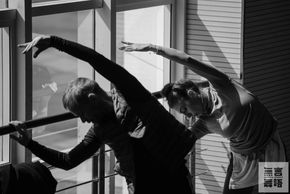Learning by exploring

teaching and intentt
The teaching and training, contemporary, ballet and partnering, of Jens Bjerregaard, are structured around a common frame - INTENTT - a practical system and thinking around dancing emphasizing body knowledge, and sensory and tactile approaches without losing track of historical and artistic context.
INTENTT is a thinking about training and dancing that combines aspects of performing - both in historical as well as considering a more contemporary approach to performing, thus finding logic and functionality in the work. As INTENTT work is embracing Contemporary, Partnering and Ballet, we aim to use a universal teaching language and input that does not limit itself to a style.
In contemporary there is fundamental work on body functionality - not the least the work, architecture and functionality of the spine and the simple presence in space.
Partnering deals with the intertwined relationship between the functional and emotional body.
In Ballet, we work on understanding our existence in front of an audience (en place, en face, decors/dedans) looking at the technique as a tool to communicate. You cannot free ballet from its somewhat dubious history - knowing it, is to liberate yourself from it, but you can use ballet as a tool for movement and body understanding.
Dance classes and workshops
Class #1 Flow and awareness
Class #1 Flow and awareness

The Contemporary class of Jens Bjerregaard has been informed by the Cunningham technique, yoga and sports all reflecting Jens's choreographic practice.
The work emphasizes flow and solid body awareness - always conscious of creating and understanding connections within the body and beyond.
The dancers are challenged to explore their possibilities and presence as performers to go further than their perceived limits.
The physical body and the memory are explored equally thus creating a practical awareness and functional development of the movement.
In all exercises and corrections, you need to consider that you are dealing with an art form, an expression being conveyed to an audience, if you limit yourself to just the mechanics of movement you are doing yourself and the dancer a disservice. We should work on possibilities and the range of time, space, and the body itself – and not create limitations.
Class #2 Ballet re-explored
Class #1 Flow and awareness

A challenging and fluid ballet class that explores not only the aesthetics of ballet but also the functionality of movement and its origins free from mannerisms and other restrictions.
Behind ballet traditions also lies logic and functionality that can inform the dancer.
This class aims to demystify complicated technicalities and become aware of the chain of responses the body goes through to move freely and willingly.
The class is not bound by the traditional use of piano music. Instead, the dancing is explored by an eclectic range of music giving the dancers new musical experiences about the ballet form.
The class is aimed at contemporary and other dancers who want to become smarter movers and use the ballet language as a foundational training tool.
Class #3 Moving Together
Before we talked
before we were fully able to see
we received and gave a touch to establish a connection
As humans, we seek out touch
to seek out our humanity
unrestricted by harm or violence
dancing together is finding yourself in touch.
-
Partnering work is central to Jens's work.
It is a technical skill that demands not only strength but also care and sensibility.
This intertwined relationship between the functional and emotional body is integral to our dance practice
In this practical and fun class on partnering, movers are invited to explore a range of practical tools for partnering.
It is an invitation for them to learn a sound and well-founded way of working with a partner, a way that adapts to all movement styles and backgrounds.
The emphasis will be on the
fulfilment and freedom of the movement within a clear and user-friendly partnering language.
Class 4# Back to Basics

Dance professionals as well as non-professionals run into the same obstacles due to dysfunctional strength and unhealthy body alignment.
Developing your core strength is like giving yourself a body makeover: this goes beyond superficial strength training and asks for a balanced multidirectional development of the body.
Simple exercises mostly travelling across the floor and inspired by Animal movement, Sports Science, Pilates and Yoga, will release the tension that the body retains and allow a smooth functioning of all the joints for a healthy, pain-free posture and increased stability in motion.
Workshop #1 Visiting Movement

Despite trends and fashions, Bjerregaard has persistently followed his choreographic direction; he is extremely aware of form. His language is playful, yet sophisticated, both in his choice of music and artistic vision. His style is spellbinding and displays a certain ‘Scandinavian feel’, based on a consciousness of form and visual design. In this workshop, dancers are invited to visit choreographic material and explore their own - new - abilities inside it.
Workshop #2 Creative Tools
The aim of this work is to provide dancers with applicable and critical knowledge in their approach to improvisation and composition. The work is approached from a theatrical perspective, with a practical emphasis on spatio-temporal tools.
The exercises revolve around the following three approaches to dance:
Temporal tools :
- Coordinated time
- Sequential time
- Isolated time
Spatial tools :
- Directed
- Anchored
- Transported
Performance tools :
- En place
- En face
- En dehors/dedans
Dance classes and workshop videos
Beijing Dance camp, 2019
Moving together workshop with students from China, Australia, USA, Taiwan and Hong Kong
Copyright © 2025 Aurora-borealis - Tous droits réservés.